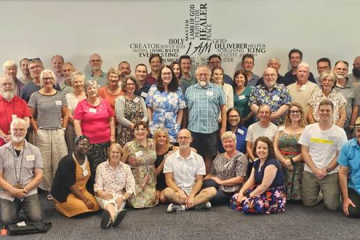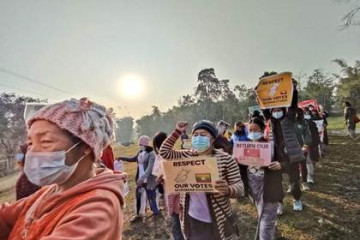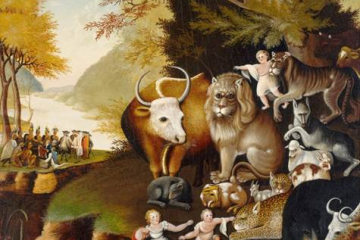Scars – John 20:19-29
I have a scar on my left foot. It’s three centimetres long and I got it when I was four and my dad had taken me to a scrap metal yard. (Parenting in the early 70’s!) The yard had a guard dog and I decided it was large enough to be a horse. The dog, however, disagreed, snarled, and threw me off, and I landed on a pile of sheet metal, slicing open my foot.
I have a second scar, just below my knee, from when I was five and playing hide and seek under a house and fell down onto a board that had nails sticking out of it. A tetanus injection and lots of antibiotics later, I lived – obviously – because here I am telling the tale.
I am sure many of you have stories about the scars on your bodies.
Some of those stories are nostalgic or hilarious when retold now. Some of them are reminders of past suffering, tokens of resilience we have gained. Some, however, are evidence of ongoing trauma. That is what scars do. They write onto our skin the stories of our lives.
Which is why when the resurrected Jesus appears to his disciples, here in John, chapter 20, he shows them his scars – his hands and his side. He does this on both occasions; on the evening of the day of resurrection, and when he appears one week later to the disciples, including Thomas, who was not with them the Sunday before.
The encounter with Thomas called the Twin (T’omas is Aramaic for twin, as is Didymus in Greek) is often read as an account of someone moving from doubt in the resurrection to belief. And so, Thomas has also been called, ‘Doubting Thomas’, despite the fact he follows the identical pattern of belief to the other disciples! When Mary Magdalene comes to them, verse 18, saying, “I have seen the Lord,” they reserve judgement until, verse 20, “Then the disciples rejoiced when they saw the Lord.” Thomas, too, struggles to believe until he sees the Lord, and then, verse 28, he responds in commitment and faith, “My Lord and my God!”
Perhaps we should call him, ‘Faithful Thomas’ – not ‘Doubting Thomas’ – and perhaps we should re-examine the role of doubt in our own patterns of belief. Jesus’ words to Thomas, “Do not doubt, but believe…” are an injunction to keep on pressing into faith – not to deny doubt and the role doubt can play in deepening, in opening up, our faith.
But these encounters between Jesus and the disciples, and their emphasis on doubt and belief and woundedness, seem to me not to be questioning the resurrection, i.e., did the resurrection of Jesus actually take place? but to be questioning what resurrection means, i.e., does the resurrection have a place in my life, in my community, in the world I live in?
Because for Thomas and for us, our questions about how resurrection works in our lives are gaping wounds. As we hear those Christians in Ukraine faithfully reading a psalm of trust and deliverance, we want to know what resurrection means. As we hear of renewed conflict in northern Afghanistan, of the bombing of Hazara Shiite mosques and schools, killing dozens of adults and students, we want to know what resurrection means. As we reflect again this weekend on the lives of over 100,000 Australians killed in war, we want to know what resurrection means. As we think about the 6.2 million people killed by Covid 19 so far, we want to know what resurrection means. As we think about our own heartbreaks and those of our family and friends, we want to know what resurrection means.
The poet, Denise Levertov, who after a “slow movement from agnosticism to …faith” was converted at 60 identified strongly with the story of Thomas. In her poem, St Thomas Didymus, she imagines him relayed not to a biological twin, but a spiritual twin – the father of the boy possessed by a spirit from Mark 9:14-29, the one who cries out, “I believe; help my unbelief!” She identifies his unbelief – and Thomas’s unbelief – as woundedness, as a longing for resurrection and describes their first encounter this way:
In the hot street at noon I saw him
a small man
gray but vivid, standing forth
beyond the crowd’s buzzing
holding in desperate grip his shaking
teethgnashing son,
and thought him my brother.
I heard him cry out, weeping and speak
those words,
Lord, I believe, help thou
mine unbelief,
and knew him
my twin:
a man whose entire being
had knotted itself
into the one tightdrawn question,
Why,
why has this child lost his childhood in suffering,
why is this child who will soon be a man
tormented, torn, twisted?
Why is he cruelly punished
who has done nothing except be born?
The extraordinary thing about Christian faith is that we do not worship a God who is oblivious to such suffering, or who – and this is what our passage tells us – has put behind him such suffering in his resurrection. Jesus’ resurrected body, in every gospel account, includes mentions of his scars. In the words of the prophet Isaiah:
Surely he has borne our infirmities
and carried our diseases;
yet we accounted him stricken,
struck down by God, and afflicted.
But he was wounded for our transgressions,
crushed for our iniquities;
upon him was the punishment that made us whole,
and by his bruises we are healed.
Episcopal priest and theologian Fleming Rutledge says: “The wounds of our Redeemer will always be there, for all eternity, as the sign of the price he paid…”
Writer Andy Crouch takes the significance of Jesus’ wounds even further. “If a scar is a healed wound,” he writes, “a wound that the body has marvellously managed to rescue and restore — then in some way, Christ’s entire bodily form, having suffered the ultimate injury of death but having been rescued and restored, is that of a scar. He will be worshiped, the book of Revelation (5:6) says, in the form of “a Lamb looking as if it had been slain.” Perhaps our scars, which are so often a source of shame and regret, are the truest clues we have to the full form of our resurrection bodies.”
One of the things I have discovered in my ministry and personal life – almost always painfully – and I believe I will go on discovering this – is that wounds do not simply go away. They must heal. And in that healing process there are aspects of every experience that stay with us and change who we are, and hopefully, if we have healed well, enable us to help others to heal. American pastor, Scott Dudley, writes, “Wounded people make the best healers because they know what it means to be wounded…. Sometimes the most helpful things we bring is our wounds, which is another reason Jesus kept a reminder of his.”
Is there a possibility that our woundedness can bring healing to others? Is there a possibility that our woundedness can somehow be redeemed into something new and good?
I have spoken before about the Japanese art of kintsugi, repairing broken pottery with lacquer dusted with gold. The idea is that by embracing flaws and scars, it is possible to create an even more beautiful and more valuable piece of art. If you have seen my two vases, the one that broke and Cecelia repaired as kintsugi, and the one the company sent as a replacement, you will know exactly what I mean.
American artist Makoto Fujimura, writes this in his book, Art and Faith: A Theology of Making. “Kintsugi bowls,” he says, “are treasured as objects that surpass their original ‘useful’ purpose and move into a realm of beauty brought on by the Kintsugi master. Thus, our brokenness, in light of the wounds of Christ still visible after the resurrection, can also mean that through making, by honouring the brokenness, the broken shapes can somehow be a necessary component of the New World to come.”
We do not know how our suffering world will experience resurrection, but perhaps in our woundedness and doubt, and in the woundedness of our Saviour, and in the work God sends us to do, empowered by the Spirit’s breath, work of forgiving and healing and faithfully holding our broken parts up to God we will find that we have become part of God’s New Word, of God’s resurrection of our world.
Let me close with the last part of Levertov’s poem. Thomas speaks:
So it was
that after Golgotha
my spirit in secret
lurched in the same convulsed writhings
that tore that child
before he was healed.
And after the empty tomb
when they told me that He lived, had spoken to Magdalen,
told me
that though He had passed through the door like a ghost
He had breathed on them
the breath of a living man –
even then
when hope tried with a flutter of wings
to lift me –
still, alone with myself,
my heavy cry was the same: Lord
I believe,
help thou mine unbelief.
I needed
blood to tell me the truth,
the touch
of blood. Even
my sight of the dark crust of it
round the nailholes
didn’t thrust its meaning all the way through
to that manifold knot in me
that willed to possess all knowledge,
refusing to loosen
unless that insistence won
the battle I fought with life
But when my hand
led by His hand’s firm clasp
entered the unhealed wound,
my fingers encountering
rib-bone and pulsing heat,
what I felt was not
scalding pain, shame for my
obstinate need,
but light, light streaming
into me, over me, filling the room
as I had lived till then
in a cold cave, and now
coming forth for the first time,
the knot that bound me unravelling,
I witnessed
all things quicken to colour, to form,
my question
not answered but given
its part
in a vast unfolding design lit
by a risen sun.


